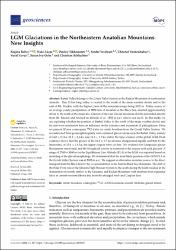| dc.contributor.author | Reber, Regina | |
| dc.contributor.author | Akçar, Naki | |
| dc.contributor.author | Tikhomirov, Dmitry | |
| dc.contributor.author | Yeşilyurt, Serdar | |
| dc.contributor.author | Vockenhuber, Christof | |
| dc.contributor.author | Yavuz, Enver Vural | |
| dc.contributor.author | Ivy-Ochs, Susan | |
| dc.contributor.author | Schluechter, Christian | |
| dc.date.accessioned | 2022-11-15T06:52:20Z | |
| dc.date.available | 2022-11-15T06:52:20Z | |
| dc.date.issued | 2022 | en_US |
| dc.identifier.citation | Reber, R., Akçar, N., Tikhomirov, D., Yesilyurt, S., Vockenhuber, C., Yavuz, V., ... & Schlüchter, C. (2022). LGM Glaciations in the Northeastern Anatolian Mountains: New Insights. Geosciences, 12(7), 257. | en_US |
| dc.identifier.uri | https://hdl.handle.net/20.500.12846/683 | |
| dc.description.abstract | Barhal Valley belongs to the Coruh Valley System in the Kackar Mountains of northeastern Anatolia. This 13 km long valley is located to the south of the main weather divide and to the east of Mt. Kackar, with the highest peak of the mountain range being 3932 m. Today, source of an average yearly precipitation of 2000 mm of moisture is the Black Sea, situated approximately 40 km to the north of the study site. Glaciers of the Last Glacial Maximum (LGM) descended directly from Mt. Kackar and reached an altitude of ca. 1850 m a.s.l. (above sea level). In this study, we are exploring whether the position of Barhal Valley to the south of the main weather divide and its east-west orientation have an influence on the existence and expansion of paleoglaciers. Here, we present 32 new cosmogenic Cl-36 dates on erratic boulders from the Coruh Valley System. We reconstructed three geomorphologically well-contained glacier advances in the Barhal Valley, namely at 34.0 +/- 2.3 ka, 22.2 +/- 2.6 ka, and 18.3 +/- 1.7 ka within the time window of the global LGM. Field evidence shows that the glacier of the 18.3 +/- 1.7 ka advance disappeared rapidly and that by the latest time, at 15.6 +/- 1.8 ka, the upper cirques were ice-free. No evidence for Lateglacial glacier fluctuations was found, and the Neoglacial activity is restricted to the cirques with rock glaciers. A range of 2700 to 3000 m for the Equilibrium Line Altitude (ELA) at the LGM was reported based on modeling of the glacial morphology. We determined that the most likely position of the LGM ELA in the coruh Valley System was at 2900 m a.s.l. We suggest an alternative moisture source to the direct transport from the Black Sea for the ice accumulation in the Eastern Black See Mountains. The shift of the Polar Front and of the Siberian High Pressure System to the south during the LGM resulted in the domination of easterly airflow to the Caucasus and Kackar Mountains with moisture from expanded lakes in central-western Siberia and from the enlarged Aral- and Caspian Seas. | en_US |
| dc.language.iso | eng | en_US |
| dc.publisher | MDPI-Multidisciplinary Digital Publishing Institute | en_US |
| dc.relation.isversionof | 10.3390/geosciences12070257 | en_US |
| dc.rights | info:eu-repo/semantics/openAccess | en_US |
| dc.subject | Erratic Boulders | en_US |
| dc.subject | Cosmogenic Cl-36 | en_US |
| dc.subject | LGM Glaciations | en_US |
| dc.subject | Eastern Anatolia | en_US |
| dc.subject | Düzensiz Kayalar | en_US |
| dc.subject | Erratische Felsblöcke | en_US |
| dc.subject | Ostanatolien | en_US |
| dc.title | LGM Glaciations in the Northeastern Anatolian Mountains: new insights | en_US |
| dc.type | article | en_US |
| dc.relation.journal | Geosciences | en_US |
| dc.contributor.authorID | 0000-0002-2644-1002 | en_US |
| dc.identifier.volume | 12 | en_US |
| dc.identifier.issue | 7 | en_US |
| dc.relation.publicationcategory | Makale - Uluslararası Hakemli Dergi - Kurum Öğretim Elemanı | en_US |
| dc.contributor.department | TAÜ, Mühendislik Fakültesi, İnşaat Mühendisliği Bölümü | en_US |
| dc.contributor.institutionauthor | Yavuz, Enver Vural | |
| dc.identifier.wosquality | N/A | en_US |
| dc.identifier.scopusquality | N/A | en_US |

















